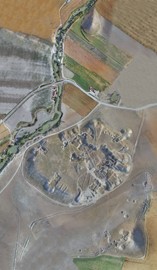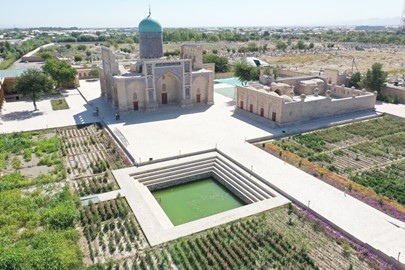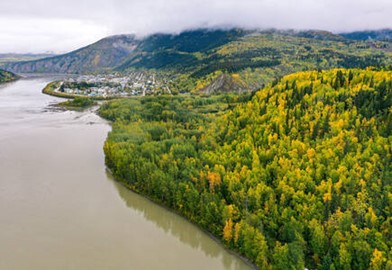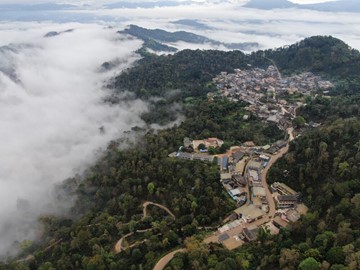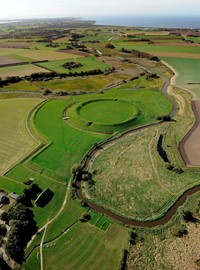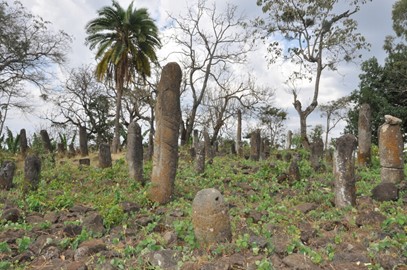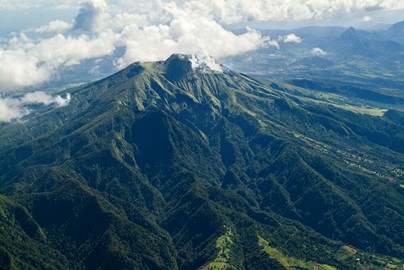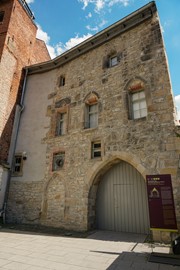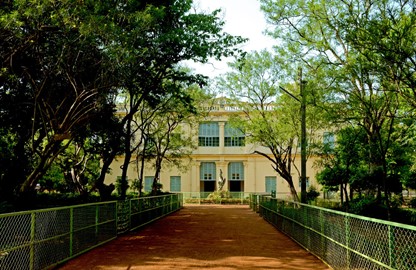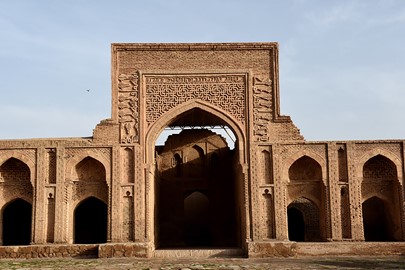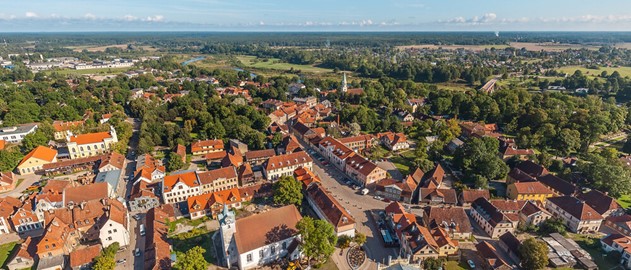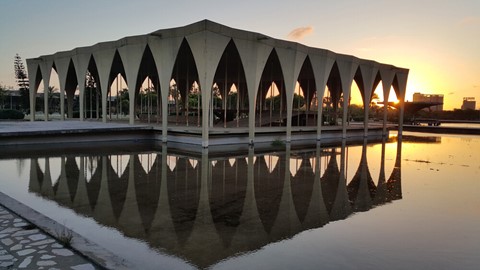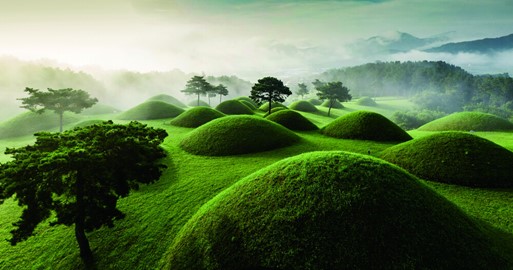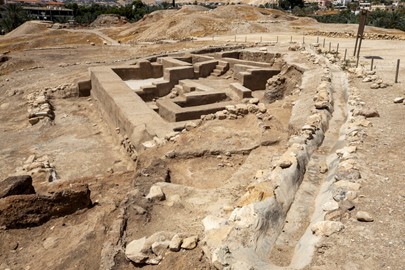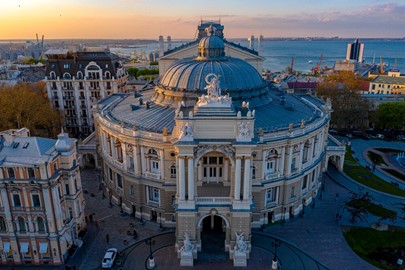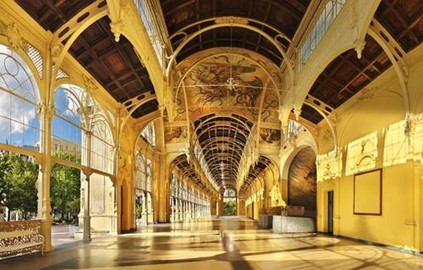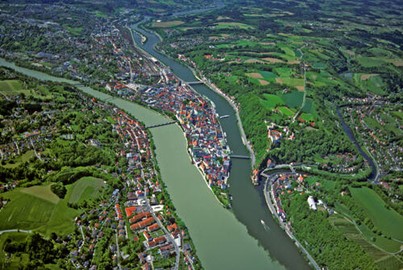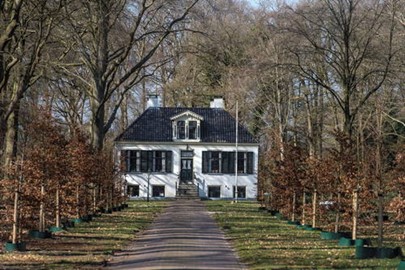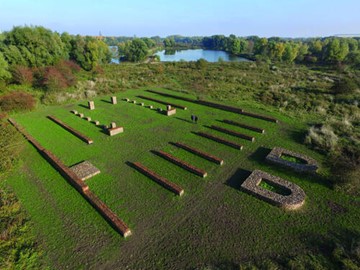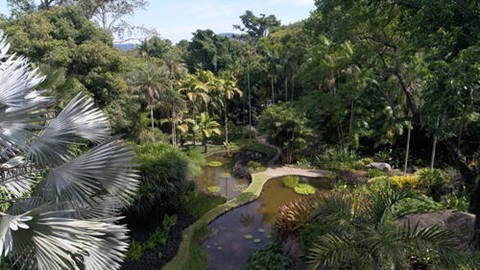search
Gordion
Gordion, a UNESCO World Heritage site in Turkey, is an ancient archaeological site near modern Yassıhöyük, celebrated as the capital of the Phrygian kingdom from the 12th to 7th centuries BCE. Spanning 13 square kilometers, it features a fortified citadel with monumental gates and palaces, extensive tumulus burials—including the famed 'Midas Mound'—and evidence of advanced Iron Age urban planning. Recognized for its historical significance as a political and cultural hub linked to the legendary King Midas, ... Read More
Silk Roads: Zarafshan Karakum Corridor
The Silk Roads: Zarafshan-Karakum Corridor, a UNESCO World Heritage site spanning Tajikistan, Turkmenistan, and Uzbekistan, is an 866-kilometer stretch of the ancient Silk Road, active from the 2nd century BCE to the 16th century CE. This corridor, running along the Zarafshan River and through the Karakum Desert to the Merv Oasis, features 31 sites, including medieval cities, caravanserais, and Sogdian settlements. Recognized for its role in facilitating trade and cultural exchange across diverse landscapes... Read More
Koh Ker
Koh Ker, a UNESCO World Heritage site in Cambodia, is a remote archaeological complex 100 kilometers northeast of Angkor, serving as the Khmer Empire’s capital from 928 to 944 CE under King Jayavarman IV. Spanning 35 square kilometers of dense forest, it features over 180 monuments, including the iconic seven-tiered Prasat Thom pyramid, sculptural lingams, and intricately carved temples. Recognized for its monumental architecture and artistic innovation, Koh Ker reflects a brief but significant shift in Khm... Read More
Tr’ondek Klondike
Tr’ondëk-Klondike, a UNESCO World Heritage site in Canada’s Yukon Territory, is a cultural landscape spanning eight sites along the Yukon and Klondike rivers, centered on Dawson City. Inscribed in 2023, it chronicles the Tr’ondëk Hwëch’in First Nation’s resilience amid the Klondike Gold Rush (1896-1898) and colonial expansion from 1874 to 1908. Featuring Indigenous settlements, trading posts, and mining relics, this 334-hectare area highlights the interplay of Indigenous and newcomer cultures in a subarctic... Read More
Tea Forests of the Jingmai Mountain
The Tea Forests of Jingmai Mountain, a UNESCO World Heritage site in China’s Yunnan Province, is a 1,513-hectare cultural landscape where ancient tea cultivation thrives. Developed over a millennium by the Bulang, Dai, and Hani peoples, it features old-growth tea forests, traditional villages, and sacred groves atop the mist-shrouded Jingmai and Mangjing mountains. Recognized in 2023 for its sustainable agroforestry and unique tea ancestor worship, this site exemplifies a harmonious blend of nature, culture... Read More
Odzala Kokoua
Odzala-Kokoua, a UNESCO World Heritage site in the Republic of Congo, is a vast 13,546-square-kilometer national park in the Congo Basin, recognized in 2023 for its exceptional biodiversity and ecological significance. Established in 1935, it encompasses pristine rainforests, savannas, and saline clearings, hosting over 7,600 western lowland gorillas, 7,300 forest elephants, and Central Africa’s richest primate diversity. Managed by African Parks since 2010, this site, part of the world’s second-largest rai... Read More
Viking Age Ring Fortresses
The Viking-Age Ring Fortresses, a UNESCO World Heritage site in Denmark, consist of five circular fortifications—Aggersborg, Fyrkat, Nonnebakken, Trelleborg, and Borgring—built around 975-980 CE under King Harald Bluetooth. Strategically located across Zealand, Funen, and Jutland, these precisely engineered earthworks, with their uniform design of ramparts, moats, and internal layouts, reflect centralized power and advanced military architecture of the late Viking Age. Recognized in 2023, they highlight Den... Read More
Gedeo Cultural Landscape
The Gedeo Cultural Landscape, a UNESCO World Heritage site in Ethiopia, is a 46,717-hectare agroforestry region in the Gedeo Zone, recognized in 2023 for its sustainable farming traditions and cultural heritage. Nestled on the eastern escarpment of the Ethiopian Rift Valley, it features ancient enset and coffee cultivation, sacred forests, and over 1,000 megalithic stelae erected by the Gedeo people centuries ago. This biodiverse mosaic of terraced slopes and traditional villages showcases a harmonious blen... Read More
Volcanoes and Forests of Northern Martinique
The Volcanoes and Forests of Northern Martinique, a UNESCO World Heritage site in the French overseas region of Martinique, spans 13,974 hectares of rugged volcanic landscapes, recognized in 2023 for its exceptional biodiversity and geological significance. Encompassing Mount Pelée, an active stratovolcano, and the Pitons du Carbet, it features lush rainforests, rare endemic species like the Martinique oriole, and dramatic volcanic formations from eruptions dating back millennia. This pristine natural reser... Read More
Jewish Medieval Heritage of Erfurt
The Jewish-Medieval Heritage of Erfurt, a UNESCO World Heritage site in Germany, comprises three well-preserved landmarks in Erfurt’s historic center: the Old Synagogue (c. 11th century), the Mikveh (c. 13th century), and the Stone House (c. 13th century). Recognized in 2023, these sites showcase the thriving Jewish community of the Middle Ages, featuring one of Europe’s oldest intact synagogues, a ritual bath, and a merchant’s residence with rare artifacts like the Erfurt Treasure. This ensemble reflects c... Read More
Santiniketan
Santiniketan, a UNESCO World Heritage site in India’s West Bengal, is a 37-hectare cultural landscape founded by poet Rabindranath Tagore in 1901 as an experimental school, later evolving into Visva-Bharati University by 1921. Recognized in 2023, it blends traditional Indian architecture with nature-inspired open-air classrooms, reflecting Tagore’s vision of holistic education rooted in creativity, humanism, and harmony with the environment. This rural retreat, surrounded by ashram-style buildings and artis... Read More
Persian Caravanserai
The Persian Caravanserai, a UNESCO World Heritage site in Iran, comprises 54 historic roadside inns spanning the country, recognized in 2023 for their role along ancient trade routes from the Achaemenid era (550-330 BCE) to the 19th century. These fortified structures, strategically spaced 30-40 kilometers apart, feature robust brick and stone architecture with courtyards, stables, and domed halls, offering shelter to travelers and merchants. Exemplifying Persian engineering and cultural exchange, sites lik... Read More
Kuldiga
Kuldīga, a UNESCO World Heritage site in western Latvia, is a well-preserved historic town that evolved from a 13th-century medieval hamlet into a key administrative center of the Duchy of Courland and Semigallia between the 16th and 18th centuries. Recognized in 2023, its old town features authentic Baltic architecture, including log buildings and foreign-influenced styles, alongside the scenic Venta River and Europe’s widest waterfall, Ventas Rumba. This 121-hectare site reflects a unique blend of local a... Read More
Rachid Karami International Fair Tripoli
The Rachid Karami International Fair-Tripoli, a UNESCO World Heritage site in Lebanon, is a 70-hectare modernist complex in Tripoli, designed by Brazilian architect Oscar Niemeyer in 1962. Recognized in 2023 and listed as World Heritage in Danger, it features a distinctive boomerang-shaped exhibition hall and over 15 innovative structures, reflecting Lebanon’s 1960s modernization ambitions. Left unfinished due to the 1975 civil war, this collaboration between Niemeyer and Lebanese engineers stands as a stri... Read More
Deer Stone Monuments
The Deer Stone Monuments, a UNESCO World Heritage site in Mongolia, are ancient megaliths scattered across the northern steppes, dating from 1200 to 600 BCE. Recognized in 2023, these 1- to 4-meter-tall stones, adorned with stylized deer carvings, are part of Bronze Age complexes in the Khangai Ridge, including burial mounds (khirgisuurs) and sacrificial altars. Found primarily at sites like Uushigiin Övör and Khoid Tamir, they reflect the ceremonial and funerary practices of Eurasian nomads, offering a uni... Read More
Gaya Tumuli
The Gaya Tumuli, a UNESCO World Heritage site in South Korea, comprises seven clusters of ancient burial mounds across Gyeongsang Province, dating from the 1st to 6th centuries CE during the Gaya Confederacy. Recognized in 2023, these 35- to 65-meter-wide tumuli, built for elite rulers, feature stone-lined chambers and artifacts like gold jewelry and armor, reflecting Gaya’s sophisticated culture and trade networks. Set in urban and rural landscapes, they illustrate a distinct funerary tradition on the Kore... Read More
Jericho
Jericho, a UNESCO World Heritage site in Israel, is one of the world’s oldest continuously inhabited cities, with archaeological remains dating back to 9600 BCE. Recognized in 2023 as 'Tell es-Sultan,' this 9-hectare site in the Jordan Valley features a prehistoric tell with evidence of the first sedentary Jewish communities, including a monumental stone tower and mudbrick walls from the Pre-Pottery Neolithic period. Its fertile oasis setting and ancient ruins highlight Jericho’s pivotal role in the transit... Read More
Odesa
Odesa, a UNESCO World Heritage site in Ukraine, is a historic port city on the Black Sea, recognized in 2023 and listed as World Heritage in Danger due to ongoing conflict. Its 19th-century urban core, spanning 66 hectares, features a planned grid with neoclassical and eclectic architecture, reflecting its rapid growth as a cosmopolitan trade hub under Russian imperial rule. Key landmarks like the Odesa Opera House and Primorsky Boulevard highlight its multicultural heritage, blending Russian, Jewish, Greek... Read More
Ancient Kingdom of Saba
The Ancient Kingdom of Saba, a UNESCO World Heritage site in Yemen’s Marib region, is a collection of seven archaeological sites showcasing the wealthy Sabaean civilization from the 1st millennium BCE to around 630 CE. Recognized in 2023 and listed as World Heritage in Danger due to ongoing conflict, it features monumental temples, ramparts, and the remarkable Ma’rib Dam—an ancient engineering feat that created the largest man-made oasis in South Arabia. Situated in a semi-arid landscape, these remnants hig... Read More
Great Spa Towns of Europe
The Great Spa Towns of Europe, a UNESCO World Heritage site, encompass 11 historic spa towns across seven countries—Austria, Belgium, Czechia, France, Germany, Italy, and the UK—recognized in 2021 for their shared cultural legacy from the 18th to early 20th centuries. These towns, including Bath, Baden-Baden, and Karlovy Vary, feature elegant architecture, landscaped parks, and mineral springs, developed as therapeutic retreats for Europe’s elite. Reflecting the rise of balneotherapy and leisure culture, th... Read More
Danube Limes
The Danube Limes, a UNESCO World Heritage site in Europe, is a section of the Roman Empire’s northern frontier along the Danube River, recognized in 2021 across Austria, Germany, and Slovakia. Spanning 493 kilometers, it includes 77 sites—fortresses, watchtowers, and settlements like Carnuntum and Regensburg—built between the 1st and 5th centuries CE to defend against Germanic tribes. This well-preserved network of military architecture and infrastructure highlights Roman engineering and urban planning, off... Read More
Colonies of Benevolence
The Colonies of Benevolence, a UNESCO World Heritage site spanning Belgium and the Netherlands, consist of four agricultural settlements—Frederiksoord, Wilhelminaoord, Wortel, and Veenhuizen—established in the early 19th century. Recognized in 2021, these planned communities were founded by the Society of Benevolence to alleviate poverty through farming and self-sufficiency, featuring orderly layouts with worker cottages, schools, and fields. Covering 4,571 hectares, they reflect an innovative social experi... Read More
Lower German Limes
The Lower German Limes, a UNESCO World Heritage site spanning Germany and the Netherlands, is a 400-kilometer stretch of the Roman Empire’s northern frontier along the Lower Rhine, recognized in 2021. Comprising 102 sites—including forts, harbors, and civilian settlements like Xanten and Nijmegen—it was constructed between the 1st and 5th centuries CE to secure the empire’s northwest border. This well-preserved archaeological ensemble showcases Roman military engineering, river-based infrastructure, and urb... Read More
Sítio Roberto Burle Marx
The Sítio Roberto Burle Marx, a UNESCO World Heritage site in Brazil, is a 40-hectare estate in Rio de Janeiro’s Barra de Guaratiba, recognized in 2021 as a cultural landscape. Created by landscape architect Roberto Burle Marx from 1949 until his death in 1994, it features modernist gardens with over 3,500 tropical plant species and seven structures, including his home and studio. Donated to Brazil in 1985 and managed by IPHAN, this site exemplifies his innovative tropical design, merging art, nature, and c... Read More
Chinchorro Culture
The Chinchorro Culture, a UNESCO World Heritage site in Chile’s Arica and Parinacota Region, recognized in 2021, preserves the world’s oldest known artificial mummification practices, dating back over 7,000 years. This coastal hunter-gatherer society thrived in the Atacama Desert, leaving behind three key sites—Faldeos del Morro, Colón 10, and Camarones—featuring cemeteries with naturally and artificially mummified bodies. These sites reflect the Chinchorro’s complex spirituality and adaptation to an arid e... Read More
